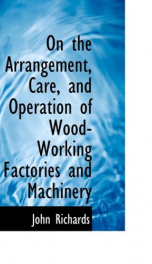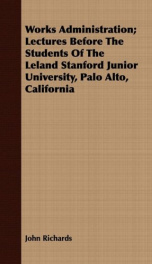on the arrangement care and operation of wood working factories and machinery

PREFACE. IN the Treatise on the Construction and Operation of Wood-working BIachines, it was necessary to introduce a large number of expensive engravings, and to treat of many things not directly connected with the processes of wood conversion, but relating entirely to the construction of machines. This, while it added to the value of the work for engineers and machinists, at the same time extended its cost, and pl v a . c e d --, . i .. t -. . b. beyond the means of machine operators and whd mechanics generally besides, the pian of the work did not include the practical details of shop manipulation. In view of this fact, and further to promote the development of wood manufacture, it has been considered expedient to supplement the Treatise on the Construction and Operation of Wood-working Machines, with a shorter one, directed to their care and mamgement, including the plans of arranging and equipping factories for woodhwork, and particularly the details with which the practical workman has to deal. c The work is mainly based. upon American practice, which can hardly detract from its usefulness in other a 2 iv PREFACE. count, ries. The wood interest is more extended in America than elsewhere, and we have every reason to assume, that with our present facilities of intercourse, wood conversion, like other manufacturing processes, will become analogous and uniform, as it progresses and improves. J. RICHARDS. INTRODUCTION. AT the present day it may be fairly claimed that machines have supplanted hand labour in working wood. Year by year improvements have gone on, until bench work and hand skill have become comparatively unimportant element in wood manufacture and, as Professor Willis remarked before the Society of Arts, 1852, cc nothing remains to be done by hand, but to put the component parts together. None, except those who have learned their trades when and where machines were not used, can realize this change. You may tell the apprentice of to-day about going out through the snow to a board-pile, selecting your stuff, carrying it in, and after scraping off the snow in winter, or sweeping off the dust in summer, laying out the stuff with a chalkline, and straight-edge, ripping out the job by hand, setting it about the stove to dry, and then dressing it up with a jack plane. You may tell him of mortising by hand, cutting tenons and shoulders, with a backsaw, and he will look at you with an incredulous stare. NO wonder for this sort of thing has passed away, and with it, we are happy to say, some of the hardest labour that ever was dignified with the name of mechanical. I t was mechanical, nevertheless, and called for the continual exercise of judgment and skill from the cutting out to the cleaning off, it was a kind of race between brains and muscle, in which brains some INTRODUCTION. times conquered. Nany a time, as older hand workmen will remember, would a small man, without that muscular strength that seemed to be the main element in his work, have earned his dollar or two dollars more at the end of the week than his stronger competitor, simply by his superior hand skill, superior judgment, and superior tools. But now machines do the work, and the main business of the operative is to take care of, guide, and direct them. The muscular work is gone the brain work remains...
Users who have this book
Users who want this book
What readers are saying
What do you think? Write your own comment on this book!
write a commentif you like on the arrangement care and operation of wood working factories and machinery try:
Do you want to exchange books? It’s EASY!
Get registered and find other users who want to give their favourite books to good hands!




